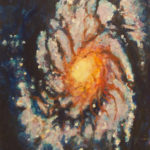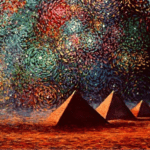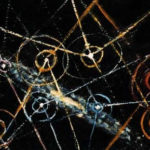In the early nineties when I retired from teaching science, math and art to high school students, I turned my efforts towards painting and astronomy. I decided to paint my passion for science. I had no idea where this would lead but this would be my niche, to paint the geometry of the universe.
I have always been interested in how the universe works but really never could imagine what was going on at the atomic level. In 1995, while working on the painting Cosmic Egg, I had the idea that we must be moving quickly through space. The Big Bang theory would have a violent, explosive beginning so motion should be evident. It took awhile for this motion to gel in my head. Our view, our reality is that we are at rest in the cosmos. Even our model of the solar system has a stationary Sun.
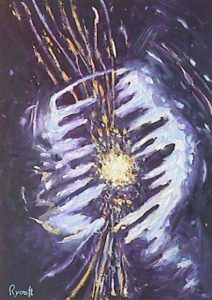
I have a broad background in the sciences, am an amateur astronomer, and have developed an interest in ancient history. Once I had access to the internet I could expand my research beyond book stores and libraries. I searched for physicists’ papers about motion but not much was written about matter in motion. It made me think that I might have an original idea. Motion seems to explain a lot of phenomena.
Scattered throughout these pages there are images of my paintings. These paintings are a record of my explorations. My canvas is like a physicist’s blackboard. Before doing a painting of a subject, I familiarize myself with the science, and I research many ideas. These are my tools. I draw an idea and put it to paint. I am often surprised at how an idea in geometry can be solved by the act of exploring with paint. Many physicists believe that artists have a special place in understanding the universe.
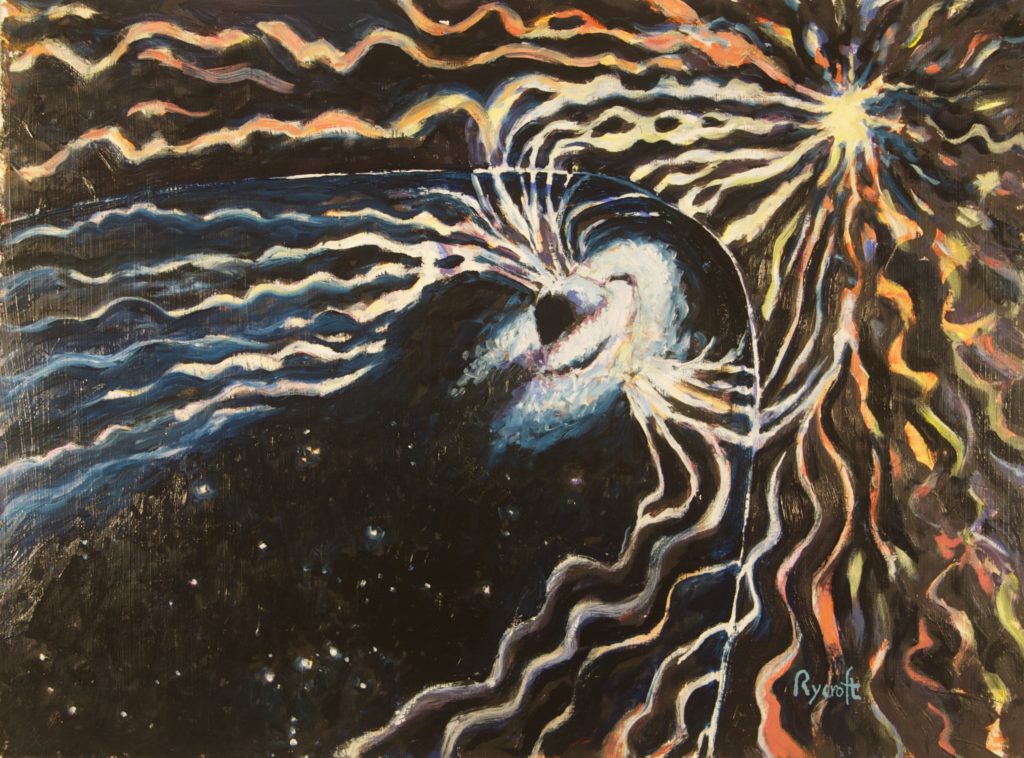
Leonard Shlain was a medical doctor who wrote an excellent book on the relationship between art and physics. In his revolutionary book Art and Physics: Parallel Visions in Space, Time and Light, Shlain proposes that the visionary artist is the first member of a culture to see the world in a new way. Then, nearly simultaneously, a revolutionary physicist discovers a new way to think about the world. Escorting the reader through the classical, medieval, Renaissance and modern eras, Shlain shows how the artists’ images when superimposed on the physicists’ concepts create a compelling fit.
Throughout, Shlain juxtaposes the specific art works of famous artists alongside the world-changing ideas of great thinkers. Giotto and Galileo, da Vinci and Newton, Picasso and Einstein, Duchamp and Bohr, Matisse and Heisenberg, and Monet and Minkowski are just a few of the provocative pairings.
I felt quite confident that my ideas could be of interest to the physics community and so, I set up an appointment with University of British Columbia physicist, Dr. William Unruh. He said I would get five minutes of his time but an hour later he was running off two papers on his printer. One was titled “Time, Gravity and Quantum Mechanics”, a 50 page introduction to the subject I found myself investigating. Since we first met I have seen him every couple of years. He has been very helpful and I think finds my ideas interesting. But there is a problem for tenured scientists. They have to work within the framework of established science.
I was told that “motion makes no difference in the working of the universe”. I realized I might be the only person working on an idea involving motion of matter, and how it creates the universe we see around us. I felt like a kid who had discovered a secret candy shop full of amazing treats. Motion answers a lot of questions and if this motion represents something about eternity as Greek philosopher Plato, educated in Egypt says, then putting these two ideas together seemed a good place to research. My first paintings about motion in the cosmos were exhibited at the Windspirit Gallery in Powell River in 1996.
I visited University of Victoria astronomer, Dr. Arif Babul to talk about motion in the cosmos. He liked my paintings and invited me to be the guest artist at the 2000 Victoria Cosmological Computer Conference in August. During this week long event, the astronomers were using computers to model cosmological creation. They were producing beautiful moving images, art, while I, the artist, was demonstrating science through my paintings, an interesting parallel. I met a lot of young astronomers and had some good debate and discussion.
During Princeton astronomer, Dr. Jeremiah Ostriker’s presentation, he noted that he had put his transparency in upside down. He immediately noted that it really didn’t matter as direction makes no difference in the working of the cosmos. I was able to get the microphone and ask him why direction made no difference when the evidence is that our galaxy and all the local galaxies are moving coherently in the same direction. He answered that this was true but when looking at the big picture, motion was homogenous throughout. On a video on his website he actually states that he is baffled by this wholesale motion of such large volumes of galaxies moving in one direction. He suggests there must be something very massive pulling it in that direction. This was in 2000 before the astronomers announced the discovery of Laniakea.
At the conclusion of the VCCC during Dr. Ostriker’s public lecture on the Friday night, he used Genesis to support big bang theory and modern cosmology. He spoke of having the big picture in focus and the end of science. I emailed him and pointed out that big bang theory does a poor job of defining Genesis. What are the ‘waters’ and what is meant by ‘separating the light from the dark’? If the big bang beginning of the whole universe is wrapped up in a tiny space, what is meant by ‘the deep’?”
This reinforced my thinking that the universe might well be an eternal event rather than one with a beginning. I asked myself “Is there any evidence on this planet that we might be living in an eternal universe?” My immediate answer. “Pyramids!” If our planet had evolved without any other agent but evolution, then, there shouldn’t be large monuments, often built with megaton-sized stones scattered across the planet.
Because I have a science background, I trust a scientific view of the world, and I certainly believe that evolution works. There is a newly evolved species right here where I live, a stickleback fish less than 10 000 years old, a very short time geologically and with evolution, a rare event. But, just because evolution works, doesn’t mean it is the only solution. Other agents could be at work that explain why we do not understand what the megalithic builders were doing. Evolution may not be an exclusive explanation.
Part of my quest to meet scientists has been to find a sympathetic ear. Bill Unruh said after our first meeting, “You haven’t done the math and I’m not doing it for you.” Now I know why. The mathematics used by astrophysicists is not the algebra and geometry I am familiar with. I note one thing about this – today’s math is almost all symbolic, mostly Greek. Isaac Newton, author of the Principia and the Law of Gravity, actually drew pictures of his geometry. Today these beautiful images are gone, reduced to symbolic algebra. These shortcuts might be part of the problem – they circumvent working with compass and straight edge which is very different than symbolic representation.
The same thing has happened in astronomy. Astronomers no longer use constellations to refer to the night sky. They use coordinates for latitude and longitude. Gone or forgotten is the mythology associated with the night sky. And to further exacerbate the problem, city light is outshining the stars at night. It is time to revisit the sky and the mythological stories that are represented by constellations from ancient times before we forget these important myths.
I think the path the scientists have chosen has led them astray. They have ventured off the main trail and followed the leaders into the forest. They have lost their way and it is always difficult to go back and pick up the trail. That is what I am doing, going back to pick up the trail that leads back to the builders of antiquity and the science they have hidden in plain sight in their monuments across the land. I estimate that there are more than a billion man hours of very hard work done before written language and in many cases before agriculture was invented. All this effort must have meaning.


